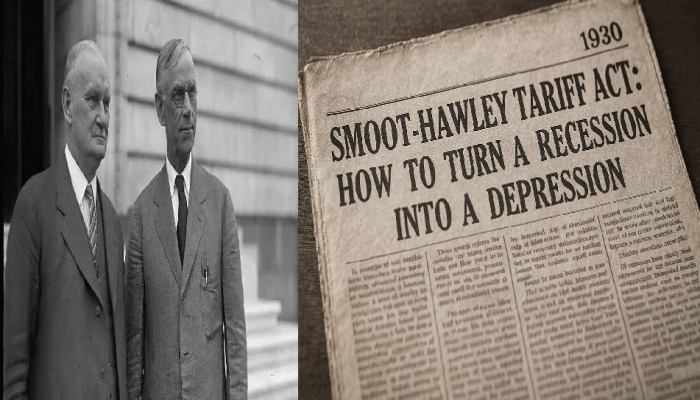The Smoot-Hawley Tariff Act of 1930 – Lessons for Modern Trade Wars
- In Economics
- 12:39 PM, Sep 17, 2025
- Dhiresh Kulshrestha
Introduction
Trade policy has always been important for countries trying to balance domestic protection with international competitiveness. However, the struggle between protectionism and openness can significantly influence not only national economies but also the global trade system. The Smoot-Hawley Tariff Act of 1930, which was enacted during Herbert Hoover’s presidency, serves as a classic example of how protectionist policies can worsen economic crises instead of helping. This article reviews the Act, its economic effects during the Great Depression, and its lasting impact while also comparing it to recent U.S. trade conflicts, particularly the U.S.-China tariff war from 2018 to 2020.
In 2025, the current tariff war started by the Trump administration 2.0 has targeted other countries, including India, China and Russia. The new world economic order is shaping as “RIC” and BRICS, and they are advocating for ‘De-dollarisation’ openly.
Historical Context of the Smoot-Hawley Tariff Act
After the Wall Street Crash in 1929, the United States found itself entering the Great Depression. Farm incomes had been falling throughout the 1920s, and more industrial workers were losing their jobs as global demand decreased. In this context, American farmers and manufacturers pushed for tariff protections, thinking that protecting domestic markets would help maintain jobs and incomes.
This effort led to the Smoot-Hawley Tariff Act of June 1930, named after Senator Reed Smoot and Representative Willis C. Hawley. It became one of the most protectionist trade policies in U.S. history.
Key Provisions of the Act
- Increased tariffs on over 20,000 imported goods
- Raised the average tariff rate on taxable imports from 38% to nearly 60%
- Extended protection to both agricultural and manufactured goods
Economic Consequences
The effects of the Smoot-Hawley Tariff Act were quick and severe. Although it aimed to protect domestic jobs, it had the opposite effect as retaliatory tariffs from U.S. trading partners damaged international trade.
|
Year |
Avg. Tariff Rate (%)—increasing and then decreasing |
U.S. Exports (Billion US$)- declined |
Unemployment (%)- increasing |
|
1928 |
38 |
5.2 |
4.2 |
|
1929 |
40 |
4.9 |
8.7 |
|
1930 |
60 |
3.8 |
15.9 |
|
1931 |
60 |
2.4 |
23.6 |
|
1932 |
60 |
1.9 |
24.9 |
|
1933 |
60 |
1.7 |
25 |
|
1934 |
55 |
2.2 |
21.7 |
|
1935 |
50 |
2.8 |
20.1 |
The diagram below discusses the ‘Impact of Smoot-Hawley Tariff (1928–1935)’ on US economy and the world economic order
- Green Bars: Average tariff rates (%)
- Blue Line: U.S. exports (Billions of USD)
- Red Line: Unemployment (%)
The diagram shows a clear connection between rising tariffs and economic decline. As tariffs increased in 1930, exports dropped sharply and unemployment rose, intensifying the depression.
International Repercussions
- Retaliation: Canada, Europe, and Latin America imposed counter-tariffs on U.S. goods.
- Global Trade Collapse: World trade shrank by nearly 66% between 1929 and 1934.
- Economic Nationalism: Many countries focused inward, creating political unrest in Europe that contributed to World War II.
- Current Economic Nationalism 2025 is not possible because of interconnectedness with each other as a global village
Lessons from the Smoot-Hawley
- Protectionism can backfire - while it aimed to protect jobs, it resulted in mass unemployment.
- Global interdependence matters - retaliation worsened the economic downturn.
- Long-term institutional changes - the Act’s failure led to the creation of GATT (1947) and later the WTO to lower trade barriers and prevent tariff wars.
Connecting to Modern Trade Wars: U.S.-China-India (2018–2025)
Fast forward nearly nine decades, and the United States again faced a high-profile tariff war in 2025 — this time with China, India and Europe during the Trump 2.0 administration. Although the global economy is not in depression, the similarities with the Smoot-Hawley are striking.
U.S.-India-China-Europe Tariff War Highlights
- Started in 2018, aimed at $370 billion worth of Chinese imports.
- Tariffs ranged from 10% to 25% on electronics, steel, and consumer goods.
- China retaliated with tariffs on $110 billion worth of U.S. goods, particularly in agriculture (soybeans, pork, corn).
- again started in 2025, aimed to “MAGA”- “Make America Great Again’ -to make a global leader
Economic Impact
- U.S. agriculture saw a 30% drop in soybean exports to China in 2018.
- The IMF estimated the trade war cut global GDP by 0.8% in 2019, about $700 billion.
- Supply chains faced disruptions, and global markets endured volatility.
- Both cases show a drop in trade volumes following tariff increases.
- Retaliation heightened the economic fallout.
- Unlike in 1930, global institutions (WTO, IMF) helped avoid a total collapse.
The economic impact of the tariff war of 2025 is shaping the new economic world order, and it will create India-China as a new economic power in South Asia. Europe can rethink their policies to set its presence in the changing economic realignments.
Critical Differences
- Economic Context: The Smoot-Hawley Tariff worsened an existing depression; the U.S.-China trade war happened during an economic expansion but created uncertainty.
- Global Institutions: The WTO helped settle disputes, preventing total breakdowns.
- Policy Objectives: Smoot-Hawley sought to broadly protect farmers and manufacturers; the U.S.-China tariffs aimed at reducing trade deficits and pressuring China over intellectual property theft.
Currently, USA President Donald Trump 2.0 is trying to make the US leader by bullying neighbours and trade partners. It is backfiring on the US economy and will cause trouble for the US economic stability.
Policy Implications for the Future
- Avoid unilateralism: Coordinated policies work better than isolationist tariffs.
- Global supply chains are fragile: Modern economies are more interconnected, making tariff wars riskier.
- Economic diplomacy is key: Constructive engagement is a more sustainable approach than protectionist retaliation.
Conclusion
The Smoot-Hawley Tariff Act of 1930 serves as a warning about the dangers of excessive protectionism. Its harmful effects on trade and employment highlight the risks of using tariffs as a blunt weapon during crises.
Although the recent U.S.-China tariff war did not cause a global depression, it reinforced the same lesson: trade wars have no winners. Instead, they destabilise economies, disrupt supply chains, and lower global growth.
Policymakers must understand that in an interconnected world, achieving lasting prosperity requires cooperation, innovation, and fair competition, not tariff barriers.
Disclaimer: The opinions expressed within this article are the personal opinions of the author. MyIndMakers is not responsible for the accuracy, completeness, suitability, or validity of any information on this article. All information is provided on an as-is basis. The information, facts or opinions appearing in the article do not reflect the views of MyindMakers and it does not assume any responsibility or liability for the same.







Comments